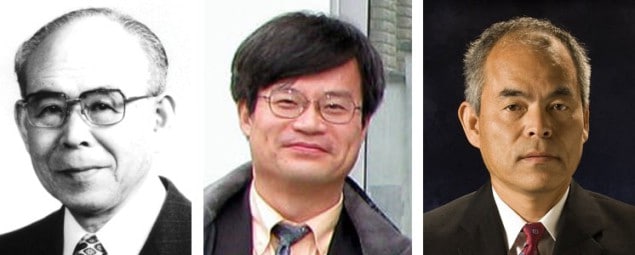
The 2014 Nobel Prize for Physics has been awarded to Isamu Akasaki, Hiroshi Amano and Shuji Nakamura for their development of blue LEDs. The prize is worth SEK 8m (£690,000) and will be shared by the three winners who will receive their medals at a ceremony in Stockholm on 10 December.
Akasaki is a Japanese citizen and works at Meijo University and Nagoya University. Amano is a Japanese citizen and works at Nagoya University. Nakamura is a US citizen and works at University of California, Santa Barbara.
The prize citation honours the trio for “the invention of efficient blue light-emitting diodes which has enabled bright and energy-saving white light sources”. The now ubiquitous LEDs are used in a wide arrange of applications from televisions to sterilizers and do not contain toxic mercury that is found in fluorescent lamps.
Three-colour blues
A source of white light needs LEDs that deliver red, green and blue light. The first red LED was created in the 1950s and researchers then managed to create devices that emitted light at shorter wavelengths, reaching green by the 1960s. However, researchers struggled to create blue light.
In the 1980s Akasaki and Amano working at Nagoya University and Nakamura working at the Nichia Corporation focussed on the compound semiconductor gallium nitride (GaN), which could be ideal for creating blue LEDs because it had a large band-gap energy corresponding to ultraviolet light.
There were many challenges, however, in making useable LEDs based on GaN. One major problem was how to create high-quality crystals of GaN with good optical properties. This was solved independently in the late 1980s and early 1990s by Akasaki and Amano and also by Nakamura. Both teams used metalorganic vapour phase epitaxy (MOVPE) techniques to deposit thin films of high-quality GaN crystals onto substrates.
Doping discovery
Another seemingly insurmountable challenge facing the researchers was how to dope the GaN so it is a p-type semiconductor, which is crucial for creating an LED. Akasaki and Amano noticed that when GaN doped with zinc is placed in an electron microscope, it gives off much more light. This suggested that electron irradiation improved the p-doping – an effect that was later explained by Nakamura.

The next step for both teams was to use their high-quality, p-doped GaN along with other GaN-based semiconductors in multilayer “heterojunction” structures. Nakamura was then able to create the first high-brightness blue LED in 1993.
Praising the laureates, the chair of the Nobel committee for physics Per Delsing said “A lot of big companies tried to [develop blue LEDs] and they failed, but these guys persisted and eventually they succeeded.”
Today, GaN-based LEDs are used in back-illuminated liquid-crystal displays in devices ranging from mobile phones to TV screens. LEDs emitting blue and ultraviolet (UV) light have also been used in DVDs, where the shorter wavelength of the light allows higher data-storage densities. Looking into the future, UV-emitting LEDs could be used to create basic yet effective water-purification systems, because UV light can destroy micro-organisms.
Invention or discovery?
Over the past 10 years there have been three other physics Nobel prizes awarded for work with significant commercial potential: giant magnetoresistance in 2007; fibre optics and charged-coupled devices in 2009; and graphene in 2010. While most prizes are associated with more esoteric discoveries, like the Higgs boson, Alfred Nobel decreed in his will that the prize could also be given for an important invention in physics.
“Alfred Nobel would be very happy about this prize,” says Delsing. “[The blue LED] is really something the will benefit most people.”
David Gross from the Kavli Institute for Theoretical Physics at University of California, Santa Barbara, who shared the 2004 Nobel prize for his work on asymptotic freedom, is happy that in recent years both pure and applied research are being recognized. After addressing a meeting in Trieste to mark the 50th anniversary of the International Centre for Theoretical Physics, where he had stressed the importance of blue-sky research, Gross told Physics World that “Every five or six years the prize is awarded to an invention that has conferred a great benefit to humankind, such as the transistor, the laser and fibre optics. I think the existing ratio is just about right.”
Akasaki was born in Chiran, Japan, in 1929. He graduated from Kyoto University in 1952 and received his PhD in 1964 from Nagoya University.
Amano was born in Hamamatsu, Japan, in 1960. He received his PhD in 1989 from Nagoya University.
Nakamura was born in Ikata, Japan, in 1954. He graduated from the University of Tokushima in 1977 with a degree in electronic engineering and obtained a Master’s degree in the same subject two years later. He then joined the Nichia Corporation, a small company located in Tokushima on the island of Shikoku. Nakamura was awarded a PhD in 1994 from University of Tokushima.



